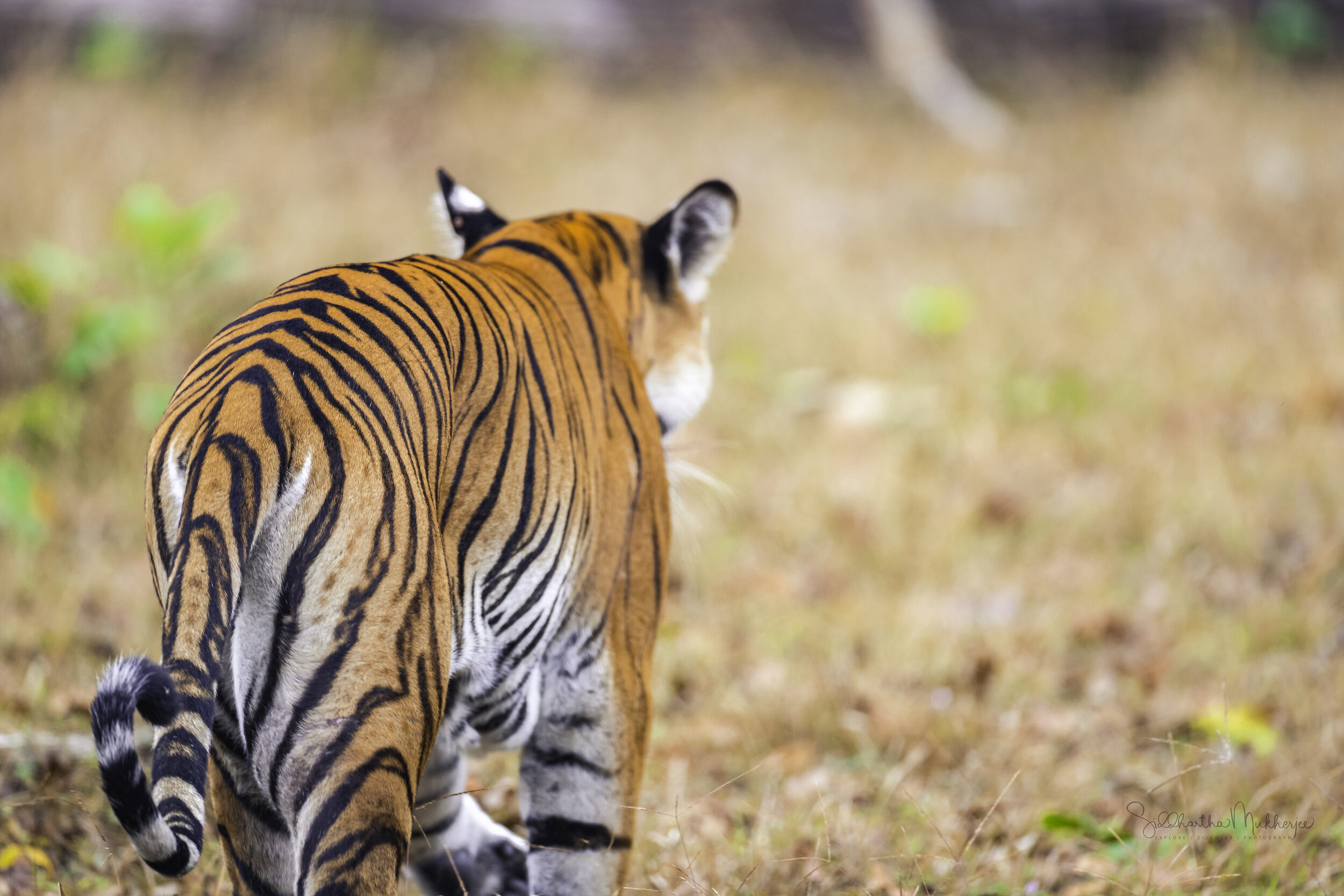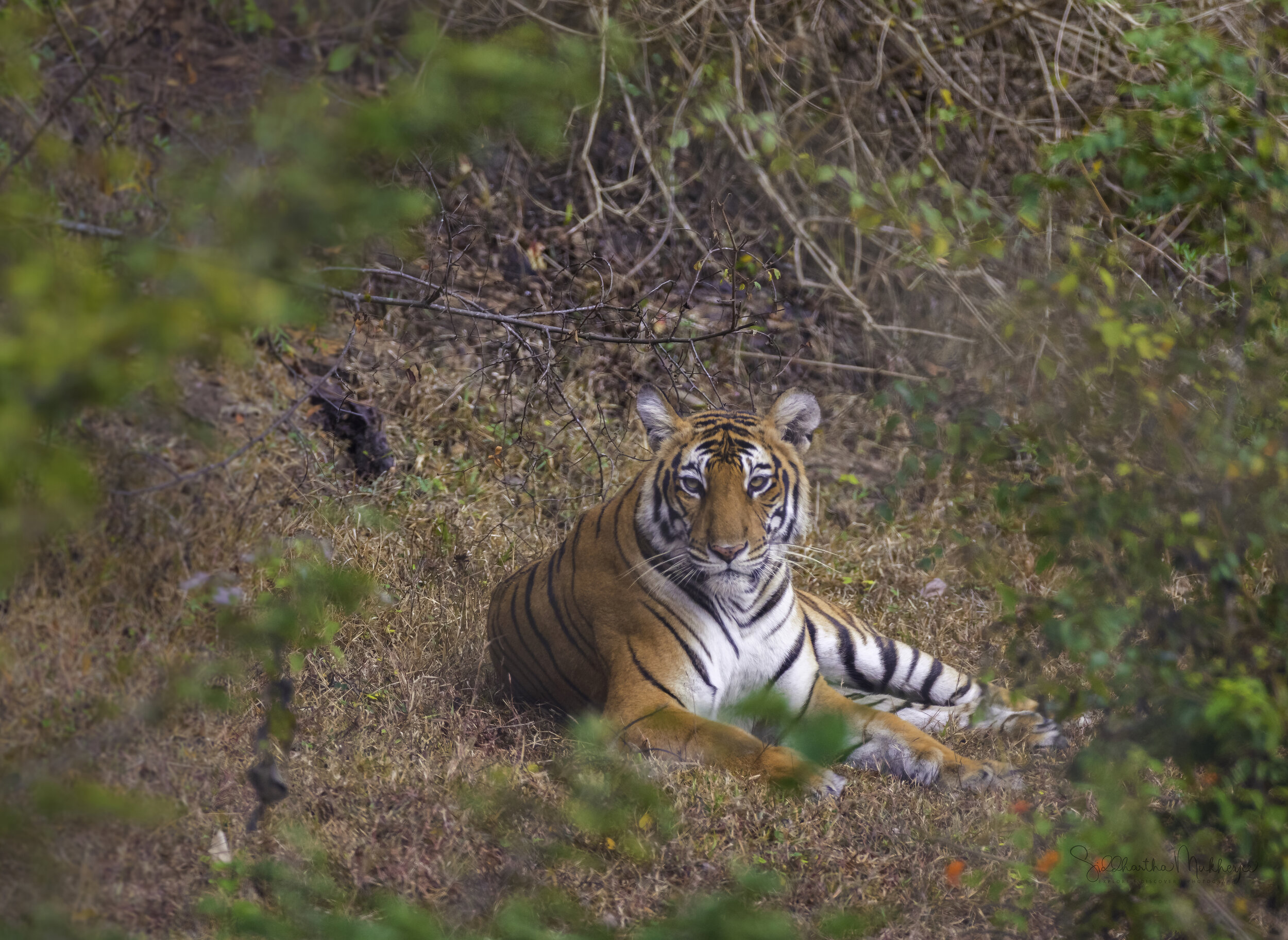Tigers of Kabini
The Backwaters Female & the Tiger Tank Female
Panthera tigris tigris
ENDANGERED
Kabini
The presence of a tiger changes the jungle around it, and those changes are easier to detect. Bird calls darken, small deer call softly to each other. Herds do not run but drift into shapes that suggest some emerging group consciousness of an escape route. A kind of shiver seems to run through everything, a low hum that sounds — literally, in the whispered Hindi conversation of the guides — like sher, sher, sher! This zone of apprehension follows the tiger as it moves. Often, the best way to find a cat is to switch off your engine and listen. You might then hear, from a distance, the subtle changes in pitch and cadence that indicate a boundary of the zone. But even then, it is impossible to predict where, or if, the tiger will appear. I have written about this experience of meeting a tiger in the forests of Central India and you can read about a tigress and her cubs and listen, yes listen, to the jungle come alive when the Collared Tigress makes an appearance. But this time it is about the tigers of the Southern forests of India.
In the lush Nilgiri Biosphere, to the south of the famed Nagarhole Tiger Reserve & National Park, on the banks of the river Kasbani lies the area known as Kabini. A major tributary of the Cauvery, the Kasbani is also known as the Kapila River and Kabini River giving the area its name. Consisting mainly of moist deciduous forests, interspersed with teak and eucalyptus plantations, and at a lower altitude compared to Bandipur across the river, Kabini is sprinkled with open grasslands, making it easy to spot wildlife, and providing amazing photographic opportunities. Especially so in winter when the forests are a verdant green and the magnificent coats of the big cats pop. Together with the adjoining Bandipur National Park (870 km²), Mudumalai National Park (320 km²) & Wayanad Wildlife Sanctuary (344 km²), it forms the largest protected area in Southern India, totalling 2,183 km².
The erstwhile exclusive hunting grounds of the kings of Mysore, Kabini has lush forests, small rivulets, hills, valleys and waterfalls making it a veritable paradise for many species like the tiger, dhole, gaur, chital, sambhar, elephants and the leopard. One can also spot the critically endangered oriental white-backed vulture, various species of eagles and the Nilgiri wood pigeon.
Kabini has three main tiger families:
The Backwaters Family
The Tiger Tank Family &
The Russell Line Family
I had the good fortune to witness the two leading ladies of the families - the Backwaters female & the Tiger Tank female - in quick succession. I later discovered that while I was working the Backwaters female, her two cubs popped up in front of us but my eyes were riveted on the tigress and I missed seeing the cubs entirely.
“The tiger will see you a hundred times before you see him once.”
The Backwaters Family
The Backwaters Family is perhaps the prominent lineage of the Tigers of Kabini. The original Backwater Female tigress gave birth to a litter of two female cubs mid 2014 and the cubs likely parted ways a year or so later. One of the female cubs is rumoured to have crossed the Kabini River, over to the Bandipur side to establish a home range of her own, while her sister took over the areas previously controlled by her mother.
I am told the original Backwater Female had another litter of four cubs which unfortunately died soon after apparently due to a tranquilliser overdose. These cubs were never seen again, whilst her daughter from the first litter has taken on her name as the Backwater Female of Kabini.
It is said she is the most dominant tigress Kabini has ever seen. She also holds the reputation for being the boldest of the lot, often seen gracefully padding across the road like a goddess as she did for us. She has raised two litters of cubs, most likely fathered by the dominant Tiger Tank Male. The first litter had three males, and the second had two females and a male. These are, I am told, expected to grow into strong tigers of Kabini, eventually establishing territories of their own in and around the same lush ranges ruled by their mother and grandmother.
Featured here is the Backwaters female as she made her way from behind a fallen tree out into an open patch of grass and made her way across the track onto the other side. I unfortunately could not record her walking on the other side of the track as my view was a little cramped & at an obtuse angle.
For more videos: Video Shorts
‡‡‡‡‡
The Tiger Tank Family
The legendary Tiger Tank family, whose lineage rules a large part of Kabini began with a tigress called the Tiger Tank female. She was spotted with her litter of 3 cubs in October 2015 in a little part of the forest called the Burning Place.
Her litter of two females and a male, were already the hope for the future of Tigers in the lush emerald forests of Kabini. The scene was set for this beautiful family to take over the range once controlled by their mother. Unfortunately one of the female tigers was electrocuted near the Kabini Backwaters in 2018.
The surviving tigers from the litter are now named the Tiger Tank Female and the Tiger Tank Male. Bold, brave and brawny, these magnificent predators are often sighted and control the range of their mother.
Featured here is the Tiger Tank female as she made her way in the cool faint light of dawn and later when she was spotted again near a body of water.
For more videos: Video Shorts
‡‡‡‡‡










I will close with this final image I made in 2012, in these same forests, of an adolescent tigers pug mark on top of our jeep tracks - a realisation that hit us like a ton of bricks - while we were tracking the tiger, the tiger was stalking us.
“The one certainty in tiger tracks is: follow them long enough and you will eventually arrive at a tiger, unless the tiger arrives at you first.”
Related Posts





